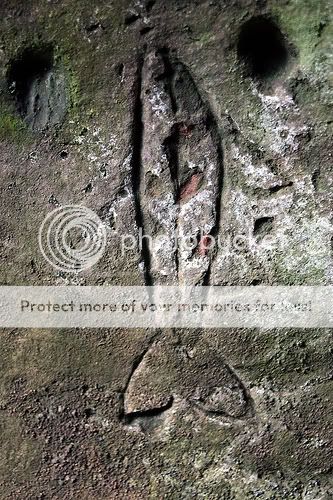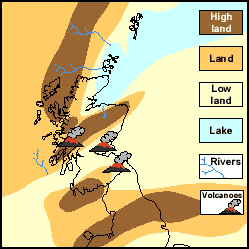The name of Wemyss is derived from the Celtic UAMH that translated simply means 'cave'.
The series of caves here at Wemyss have been used for 1000's of years for varing purposes: cave dwellers, the Picts, early Christians, Norsemen and smugglers, to the present day where they are now being appreciated for the ancient relics that they are. The caves are full of ancient markings left behind from another age, said to be the amongst the best in Britain and also the most prolific in one place - a picture can be found below:

So, how were the caves formed here?
About 6,000-7,000 B.C., the sea formed these series of caves in the sandstone cliffs. Between this date and 3,000-4,000 B.C. the land rose another 8 meters and as a result another series of caves were formed. Once again the land then rose yet another 8 meters so that now there is two series of caves:- one series at the 16 metre level and one series at the 8 metre level.
Here at the coordinates given you will be at a large open cave that you can walk inside, this is known as the East Doo Cave, (the West Doo cave being destroyed during World War I), when a gun emplacement was put on top of it. When the gun went off the cave below fell in. The East and West Dovecote Caves take their names from the fact that they were used as pigeon houses and at one time four of the caves were set up as pigeon houses in addition to the Doo-cot on the beach. The caves in Wemyss were so famous that the pigeons in them were included in the dowry of the laird's daughter, when you walk into the East Doo cave now there is a good chance some pigeons will fly out from apparently nowhere as they still roost here to this day !
There are several other caves here to explore it is well worth while going to see them all, The East Doo caves don't contain any markings, all the one's in the Doo caves were lost with the West Doo cave, however you will see all the carved out holes (supposed to be 92) for the birds to make their home in
Sandstone and its origins:
The Sandstone here is known as 'the old red sandstone', The Old Red Sandstone describes a suite of sandstone rocks deposited in a variety of environments during the 'Devonian' period (see pic)
Scotland during the Devonian
Scotland lay to the south of the equator in a semi-arid environment. Scotland was all above sea level and was in parts very mountainous. The Devonian saw the final stages of the coming together of the continents of Laurentia and Baltica (see Silurian). This collision of continents formed a mountain range across the northern half of Scotland. The mountains, named the Caledonian Mountains, were probably as high as the Swiss Alps are today, and may even have been as high as the Himalayas. It is due to 400 million years of erosion that the mountains are no longer this high today.
Scotland then and now
 This map shows the current well known outline of Scotland against how it may have looked in the Devonian period.
This map shows the current well known outline of Scotland against how it may have looked in the Devonian period.
The familiar red colour of these rocks comes from the presence of iron oxide, but not all the Old Red Sandstone is red or sandstone — the sequence also includes conglomerates, mudstones, siltstones and thin limestones and colours can range from grey and green through red to purple. These deposits are closely associated with the erosion of the Caledonian Mountain chain which was thrown up by the collision of the former continents of East Avalonia, Baltica and Laurentia to form the Old Red Sandstone Continent- an event known as the Caledonian Orogeny.
The Old Red Sandstone, in contrast to the typical formations of the Devonian, is largely a continental formation, laid down in freshwater and on land as a result of the erosion of the Highlands of the Silurian period . It is very thick in Scotland and contains a large assemblage of well-preserved fossils, particularly of the Devonian fish as can be seen below


More information about all the individual caves can be found here:
http://www.wemysscaves.co.uk/
.
To claim this Earthcache please complete the following tasks, answers via email please not in the logs, but post your photo's in the logs please:
1. Please take a picture of yourself or your GPS at the entrance of the East Doo cave.
2.Estimate the height of the East Doo cave
3.Describe the texture of the stone and what happens if you rub it gently
4.Finally, please take a picture of the erosion evident at the front of the cave.
Please enjoy your visit to this fantastic place
PLEASE NOTE: I receive a very high number of Earthcache emails, I can’t reply to them all otherwise I’d be doing nothing else all day, as has always been the case there is no need to await a reply from me regarding your answers…. However due to numerous people thinking they can just log these caches without emailing any answers, and/or completing the required tasks these will be picked up, and the logs will be deleted without further communication. To facilitate this Please email your information either before, or AT THE SAME TIME OF LOGGING THE CACHE, Thanks.